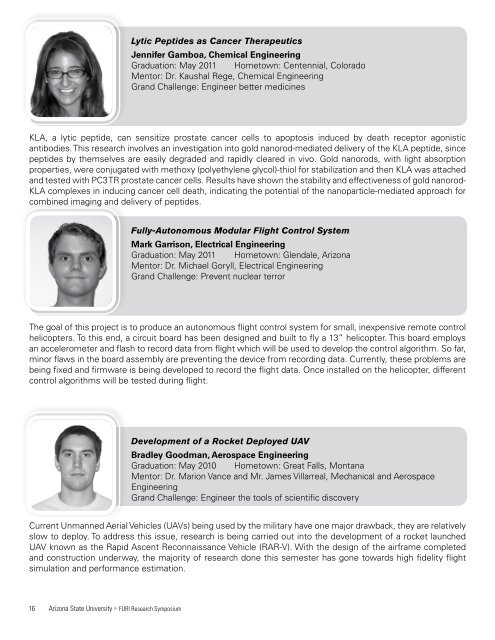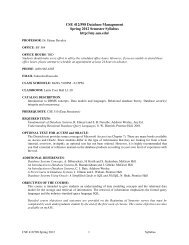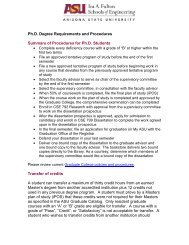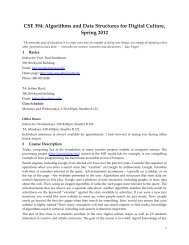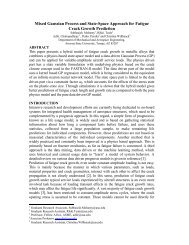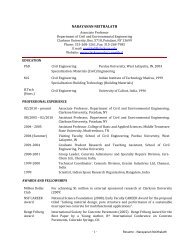Abstract Book - Ira A. Fulton Schools of Engineering - Arizona State ...
Abstract Book - Ira A. Fulton Schools of Engineering - Arizona State ...
Abstract Book - Ira A. Fulton Schools of Engineering - Arizona State ...
Create successful ePaper yourself
Turn your PDF publications into a flip-book with our unique Google optimized e-Paper software.
Lytic Peptides as Cancer Therapeutics<br />
Jennifer Gamboa, Chemical <strong>Engineering</strong><br />
Graduation: May 2011 Hometown: Centennial, Colorado<br />
Mentor: Dr. Kaushal Rege, Chemical <strong>Engineering</strong><br />
Grand Challenge: Engineer better medicines<br />
KLA, a lytic peptide, can sensitize prostate cancer cells to apoptosis induced by death receptor agonistic<br />
antibodies. This research involves an investigation into gold nanorod-mediated delivery <strong>of</strong> the KLA peptide, since<br />
peptides by themselves are easily degraded and rapidly cleared in vivo. Gold nanorods, with light absorption<br />
properties, were conjugated with methoxy (polyethylene glycol)-thiol for stabilization and then KLA was attached<br />
and tested with PC3 TR prostate cancer cells. Results have shown the stability and effectiveness <strong>of</strong> gold nanorod-<br />
KLA complexes in inducing cancer cell death, indicating the potential <strong>of</strong> the nanoparticle-mediated approach for<br />
combined imaging and delivery <strong>of</strong> peptides.<br />
Fully-Autonomous Modular Flight Control System<br />
Mark Garrison, Electrical <strong>Engineering</strong><br />
Graduation: May 2011 Hometown: Glendale, <strong>Arizona</strong><br />
Mentor: Dr. Michael Goryll, Electrical <strong>Engineering</strong><br />
Grand Challenge: Prevent nuclear terror<br />
The goal <strong>of</strong> this project is to produce an autonomous flight control system for small, inexpensive remote control<br />
helicopters. To this end, a circuit board has been designed and built to fly a 13” helicopter. This board employs<br />
an accelerometer and flash to record data from flight which will be used to develop the control algorithm. So far,<br />
minor flaws in the board assembly are preventing the device from recording data. Currently, these problems are<br />
being fixed and firmware is being developed to record the flight data. Once installed on the helicopter, different<br />
control algorithms will be tested during flight.<br />
Development <strong>of</strong> a Rocket Deployed UAV<br />
Bradley Goodman, Aerospace <strong>Engineering</strong><br />
Graduation: May 2010 Hometown: Great Falls, Montana<br />
Mentor: Dr. Marion Vance and Mr. James Villarreal, Mechanical and Aerospace<br />
<strong>Engineering</strong><br />
Grand Challenge: Engineer the tools <strong>of</strong> scientific discovery<br />
Current Unmanned Aerial Vehicles (UAVs) being used by the military have one major drawback, they are relatively<br />
slow to deploy. To address this issue, research is being carried out into the development <strong>of</strong> a rocket launched<br />
UAV known as the Rapid Ascent Reconnaissance Vehicle (RAR-V). With the design <strong>of</strong> the airframe completed<br />
and construction underway, the majority <strong>of</strong> research done this semester has gone towards high fidelity flight<br />
simulation and performance estimation.<br />
16<br />
<strong>Arizona</strong> <strong>State</strong> University u FURI Research Symposium


